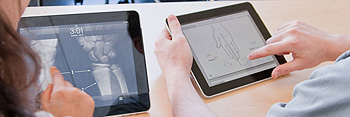August 5, 2010 - By Tracie White

Stanford EdTech
The Stanford University School of Medicine will be distributing iPads to its incoming class of 91 first-year medical school and master’s of medicine students during orientation later in August as part of a trial program to integrate the mobile device into academics.
The core goal of the iPad initiative is to improve the student learning experience. The decision to provide the devices was prompted by a desire to give students flexible access to the content that they need whether it is a virtual cadaver in dissection lab, annotated lecture slides and videos in the classroom, or journal articles for evidence-based practice in clinic.
“We want to explore the use of iPads and other technologies to help students access the enormous amount of medical knowledge that is being produced constantly,” said Charles Prober, MD, the school’s senior associate dean for medical education. “Part of the challenge facing medical students, and all doctors, is the overwhelming amount of information. Devices like the iPad may be able to help users access that pool of knowledge.”
The use of the iPads also fits into the School of Medicine’s plans to make significant changes to the current model of medical school education, featuring the official opening in September of the Li Ka Shing Center for Learning and Knowledge, the school’s first new education building in 50 years.
The five-level, 120,000-square-foot structure is expected to dramatically change the way that students and doctors are trained through the use of new interactive, experiential and team-based learning technologies.
“We’re at a major crossroads in medical education reform,” Prober said. “The tech part of that begins with this new incredible building allowing us to provide education in the most current format.”
Because the population of new students is extremely tech-savvy, it makes sense to teach them through the use of the electronic devices they’re familiar with, Prober said, adding, “We can either say, ‘That’s silly. They have to learn the old-fashioned way.’ Or we embrace where they are.”
The school will monitor the use of the iPads through regular surveys to help determine how helpful they are to students, pointing out that past experiments with similar electronic devices, such as the Kindle, in academic settings haven’t been successful.
“We really don’t know yet how the incoming medical students will use them,” said Henry Lowe, MD, senior associate dean for information resources and technology. But, as a physician using an iPad himself, he’s found the device to be extremely helpful and believes it is growing in popularity among doctors.
“Physicians are a mobile group,” Lowe said. “They’re moving around from clinic to clinic, from patient to patient. … I’ve seen a variety of reports from across the country saying that physicians have seized on the iPad as a helpful device.”
For at least one current student, there’s no question that an iPad is helpful with her medical education.
“Pretty much this is a perfect tool for what I need to do,” said Stesha Doku, a 23-year-old, second-year Stanford medical student from North Carolina who recently bought an iPad. “I use it for reviewing slides from last year, for saving everything in one place. I probably won’t use my laptop in class anymore.
“Especially in medicine, we’re using so many different resources, including all the syllabuses and slides. I’m able to pull them up and search them whenever I need to. It’s a fantastic idea.”
About Stanford Medicine
Stanford Medicine is an integrated academic health system comprising the Stanford School of Medicine and adult and pediatric health care delivery systems. Together, they harness the full potential of biomedicine through collaborative research, education and clinical care for patients. For more information, please visit med.stanford.edu.